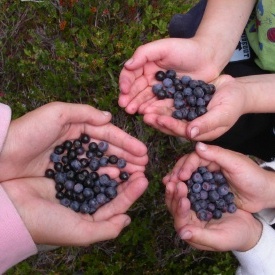Plants forming small clumps to extensive open colonies, 0.5-15 dm, rhizomatous; twigs green, sometimes glaucous, ± terete, rarely angled, usually glabrous, rarely hairy along veins or puberulent. Leaf blades usually glaucous, obovate, oblanceolate, or, rarely, elliptic, 17-35 × 9-17 mm, margins usually serrate for at least distal 2/3, surfaces usually glabrous, eglandular or, rarely, glandular throughout, often glandular-hairy along midvein. Flowers: calyx glaucous, lobes indistinct or shallow, glabrous; corolla pink, creamy pink, or red, globose to globular-urceolate, 4-6 × 5-7 mm, thin, glaucous; filaments glabrous. Berries usually blue, glaucous, sometimes dull black, maroon, or red, 9-13 mm diam. Seeds ca. 1 mm. 2n = 48.
More
A small shrub. It forms tufted mats. They are usually 10-30 cm high. It spreads by rhizomes. The young twigs are grey-green and rounded. The leaves are 15-30 mm long and 5-8 mm wide. There are broad teeth on the upper parts of the leaves. The leaves turn bright red in autumn. The flowers occur singly. They are round and creamy pink. They are 5-8 mm wide. The fruit are blue-black berries. These are 5-8 mm across and are edible.

